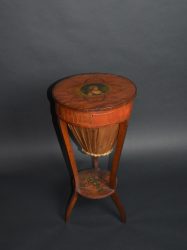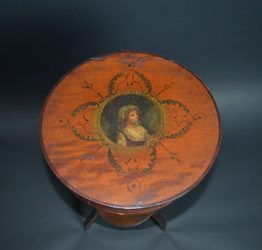

Bagged Work Table
c.1820
Maple, Satinwood, Mahogany, brass, cotton, ivory
Maker: Unknown
JJ.1958.162
This round wooden sewing table was made around 1820 and is original to the Bedford house; it is believed to have belonged to one of Jay’s daughters. The table has a painted circular design of a woman with a bonnet on top and its tripod feet have a small, upside down tulip designs on each leg. The shelf on the bottom is about 8 inches from the ground and has flowers and bow painted on the bottom, with clusters of three roses by each leg.
The top is hinged and opens to a circular insert that sits underneath the lid and on top on the bag. The insert is divided into a large half circle, a quarter circle, a small rectangle and a small hinged door that has a pin cushion on the inside when opened.
There is a cone shaped cotton bag attached to the inside of the top as well. The bottom of the bag is weighted for support and to help maintain its shape. It was originally green, but the color has faded significantly.
The lady’s worktable originated in England around 1770, and soon became popular in the United States around a decade later. Prior to this, women had sewing baskets or bags. These worktables were designed to provide a convenient surface and storage space for needlework and other leisure activities of a gentlewoman, (such as crochet, macramé or painting). They were also designed to be small, delicate and portable pieces of furniture. This allowed women of the household, and sometimes visitors, to gather in a sitting room, or parlor, and arrange themselves around the sewing table. Some women would take up their embroidery or knitting, while others might write letters or read aloud to the group.
You may view the Object of the Day Archives HERE
